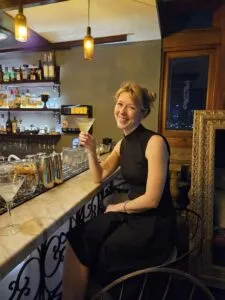
Colombia is topping the hotlists. Out with the leftist guerrillas, in with the comfortable coffee haciendas, tropical colonial cities, Caribbean islands and a progressive art and gastronomy scene.
Harry Hastings, Director of Plan South America, has been getting to grips with the best of it…

What’s the fuss?
I am always looking for an excuse to travel to Colombia. The food is extremely good and the people are charming. The capital, Bogota, is rough-hewn, cool and chaotic. English-speaking tourists, outside of Cartagena, are mercifully thin on the ground. Landscapes are impossibly lush or savagely archaic. Safe now in all but a few remote areas, there remains an illicit undercurrent and a rare sense of the undiscovered. Politics aside – always complicated here – there is real positivity about the future of modern Colombia.
24hrs in Bogota…
An early morning visit to the Paloquemao fruit and flower market, followed by a stroll around the colonial quarter of La Candelaria and a visit to the Gold Museum. Next Stop: El Bandido for a long tapas lunch. Perhaps a look-in at a backstreet emerald dealer, or the artisan next door with a stunning collection of vine-weaved Amazonian bowls and baskets. After a quick siesta, cocktails on Apache’s funky roof terrace followed by Chia’s Andres Carne de Res for one of the craziest dinner experiences on the planet. At weekends, the hip northern neighbourhood of Usaquén is jammed with good restaurants and a lively market. A ceviche lunch at La Mar never fails.

And where next?
The Coffee region is a must. We recommend splitting time between a working hacienda and a 4-room private house with jaw dropping views over the Quindío Valley. Days are spent exploring the local plantations, riding, trekking, biking, rafting, picnicking and hot air ballooning. Both places have wonderful pools and talented chefs. Then to the shady plazas, swaying hips and clip-clopping hooves of Cartagena’s Old Town, the Caribbean’s most elegant port city. We organise boat rides to private islands, rum tasting and ceviche classes, but for the most part it’s a city best explored at your own pace. Avoid the swish restaurants and major on the unassuming little boltholes with the friendliest faces and freshest fish. Almost all of our trips end at a fully-staffed private hillside retreat set in the cloud forests of the Sierra Nevada de Santa Marta. I know of few more special (or undiscovered) places in South America.
And for those who like a bit off-piste?
Los Llanos for cowboys and anacondas; La Guajira, the northernmost tip of the continent, for desert, immense sand dunes and cerulean waters; Cali for salsa and one of my favourite restaurants. I still haven’t made it to Leticia, in the Amazon, but it’s next on the list – as is Sucre: I remember driving for hours through improbably lush pastures populated by plump blanched Brahman cattle. And, of course, Mompos, a very hot, listless, isolated little town on the banks of the Rio Magdelena. Gabriel Garcia Marquez lived here for a while ‘Mompos doesn’t exist,” he wrote, “we sometimes dream about her, but she doesn’t exist.”
Related Stories

Discovering the Colombia of 100 Years of Solitude: a journey inspired by Gabriel García Marquez

Art Travel in Mexico City

Cuba with Hattie: A Journey to Havana and Trinidad

Uruguay: The Ultimate Road Trip
@plansouthamerica


